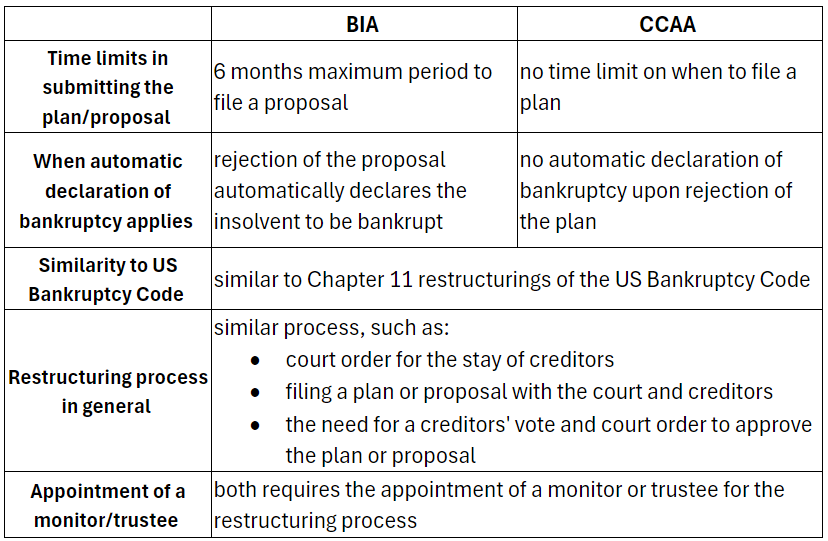When it comes to their finances, there are certain words that businesses dread, and the top spots go to insolvency and bankruptcy. Under the lens of Canadian laws, bankruptcy, insolvency, and restructuring are processes that offer a positive and saving grace for businesses.
In this article, we asked a lawyer to share his knowledge and expertise on insolvency and restructuring. We’ll go over the laws that cover these processes and how lawyers can help.
What happens when a business becomes insolvent or bankrupt in Canada?
When a business becomes insolvent, the law grants them two options: file for bankruptcy or undergo the process of restructuring.
Christopher Yung – a partner at Lenczner Slaght with a litigation practice focusing on commercial litigation, securities litigation, and insolvency and restructuring – elaborated on the Canadian insolvency and restructuring process.
BIA or CCAA
“Typically, the initial step is to determine which of the two insolvency and restructuring statutes in Canada will govern the proceedings: the Bankruptcy and Insolvency Act (BIA) or the Companies' Creditors Arrangement Act (CCAA),” says Chris.
According to Chris, there are two factors to help decide whether to pursue a proceeding based on the BIA or the CCAA:
- the size of the company and its liabilities; and
- whether the debtor expects the business to be restructured to return to profitable operation; sold to a third party; or have the assets liquidated and paid out
A restructuring can be done under the BIA or the CCAA, with the CCAA often chosen for restructurings.
“The CCAA is generally more favoured for restructurings because it is considered to be less rigid in its rules and more flexible in its interpretation,” Chris says.
Differences between the BIA and the CCAA
Chris provided some distinction between the BIA and CCAA. “An important distinction is that the CCAA can only be used by corporations, not individuals, and is restricted to larger corporations owing at least $5 million to creditors,” he says.
Here’s a summary of the basic differences between the BIA and the CCAA:

What is the process of a restructuring proceeding under Canadian laws?
The process of restructuring a corporation involves different processes along the way:
1. Obtaining orders
The process generally starts with obtaining orders. These orders will provide for a stay of proceedings which allows a debtor to keep its creditors at bay while formulating a plan.
“During that period, creditors and other claimants are precluded from taking steps to recover their debts, and the business can continue operating,” says Chris.
2. Appointing a monitor
Next “under the CCAA, a monitor will also be applied by the Court as an independent party to supervise ongoing operations and to advise the Court.”
The same applies to restructuring under the BIA, where a trustee will be appointed to monitor the insolvent’s business and financial affairs.
These monitors, whether under the CCAA or the BIA, will also report to the Court and to the creditors.
This video from ISED Canada briefly explains the roles of a trustee:
For more questions on insolvency and restructuring, contact a lawyer in your area. If you’re from Toronto, get in touch with one of the Lexpert-ranked best insolvency lawyers for litigation in Ontario.
3. Restructuring the corporation
During the appointment of a monitor, “a company may look to trim its overhead expenses by terminating some of its workforce, and other contracts such as leases,” says Chris.
“The goal in a restructuring is to re-order the company’s affairs so that it can continue operating as a going concern, and this may necessitate creditors and other stakeholders compromising their claims so that the resulting company does not emerge burdened by too much debt or other obligations,” he says.
4. Voting process
After a plan (for the CCAA) or a proposal (for the BIA) has been drafted, both the creditors and the Court will approve them.
Chris says that, “traditionally, these restructuring proposals were approved by votes of the creditors, though in recent years there has been a surge of restructurings implemented by way of Court approved reverse vesting orders.”
“[These] can achieve the same result but without the necessity of holding a creditor vote,” he says.
How can lawyers help in an insolvency and restructuring proceeding in Canada?
Insolvency lawyers can help clients in a lot of ways, such as advisory work when clients become insolvent or when already declaring bankruptcy. Learn more about what do insolvency lawyers do here.
However, there are times when litigation can become a part of the whole process, as shown by one of the recent work experiences of Yung.
“In Re Green Relief Inc., we advised a group of directors who joined the board in the months leading up to the restructuring, and remained on the board through the restructuring process, which ultimately resulted in a sale of the business,” Chris says.
“One contested issue was whether those directors, and other parties including legal advisors, ought to receive releases as part of the reverse vesting order.”
Chris explained that “the Court found that the releases were appropriate, after considering several factors previously considered in the Lydian International Limited decision:
- are the releases rationally connected to the plan;
- can the plan succeed without the releases;
- did the released parties contribute to the plan, will the releases benefit the debtors as well as the creditors generally; and
- are the releases fair, reasonable, and not overly broad?”
Chris says that “this approach in Canada diverges from some US jurisdictions which have ruled that these types of releases are not available under Chapter 11 plans, though that is not a uniform position in US courts.”
However, he cautions that "such releases in Canada remain discretionary and fact based and may not be available in every case.”
As such, navigating through this complex process of insolvency and restructuring can be left best to the professionals such as insolvency lawyers. Engaging with them can start as soon as financial troubles begin, so that issues that may be solved can be addressed as quickly as possible.
When a company is in financial distress, understanding the steps in financial restructuring can help them check if it’s the right option for them. Find out more in this article.
Thinking of undergoing an insolvency and restructuring proceeding? Contact the best insolvency lawyers for litigation in Canada as ranked by Lexpert.





